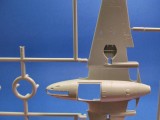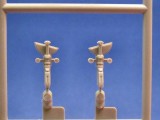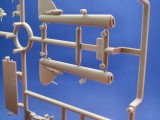iModeler Review: CyberHobby 1/72 DeHavilland Vampire FB.5
CyberHobby 1/72 DeHavilland Vampire FB.5
Kit # 5085
Parts: 40+
RETAIL PRICE: USD 24.95
The DeHaviland Vampire FB.5 is the single-seat, fighter-bomber version of Britain's second production jet fighter. Powered by the Goblin 2 turbojet , there were 930 built for the RAF, and 88 units built for exportation.
CyberHobby (DML) has recently released a brand-new tooling of this venerable part of Royal aviation history. It is an interesting mix of 21st-Century slide mold technology, and old-school Dragon mistakes.
Upon receiving my sample, I was taken by the beautiful box art rendering of a Vampire in flight. Very nicely done. Opening the box reveals three sprues, sealed in their bags. Two are in light gray plastic, and one small clear one. Also, you will notice the decal sheet-slightly smaller than A4-size, but replete with markings for 11 different machines. The RAF schemes covered are either Silver; Medium Sea Grey/Dark Green over Silver; and Medium Sea Grey/Dark Green over PRU Blue. Options include:
1) 502 Squadron RAuzAF, RNAS Sydenham, Iraq 1953 2) 202 Advanced Flying School, 1953
3) 185 Squadron RAF Habbaniyah, Iraq 1953
4) 16 Squadron, RAF Celle, Germany 1954
5) 603 Squadron, RAuxAF, RAF Turnhouse, 1954
6) 603 Squadron, RAuxAF, RAF Turnhouse, 1955
7) 602 Squadron, RAuxAF, RNAS Abbotsinch, 1954
8) 603 Squadron, RAF Gibraltar on exercise, 1955-56
9) 607 RAuxAF, RAF Ouston, 1956
10) 118 Squadron, RAF Fassberg, Germany 1953
11) 98 Sqadron, RAF Fassberg, Germany 1953
There is no accommodation for the instrument panel in decal form, nor are there very many stencils, aside from the walkway warnings. The decals (Cartograph) seem to be in register.
The instructions are old-school Dragon. The entire project is outlined in three steps, illustrated by very basic black & blue CAD-type pictures. Color call-outs are marginally vague, and presented in different shades of gray and blue.
Inspection of the parts trees of my sample reveals a bit of flash in some areas, which is surprising to me. The panel lines throughout are very deep for the scale, and in comparison to photos of the actual aircraft, appear rather spurious on the fuselage. Some of the sprue gates (where the parts attach) seem to be very heavy, particularly on the windscreen. The bottom window frame is fairly petite, yet the sprue gate supersedes it, which will most likely result in a scar on the “glass”. The separate, bubble canopy has a very fine molding seam along it's apex, much like what you see on 1/32 scale canopies. Although the photo does not reflect this, it is there and will need to be sanded and polished out.
The cockpit doesn't appear to have benefited from any research by Dragon. It is largely devoid of any detail, save for what appears to be an old-timey cash register. A decal or two for an instrument panel would have been nice, but there is not one. A few lines on the back of the rudimentary seat represent a cushion. The fuselage is a top/bottom assembly, which eliminates a wing root seam. However, the seam for joining the top and bottom halves does not match up to any of the panel lines present, and will need to be addressed. What really sets this kit apart from it's Heller/Revell and Airfix predecessors, though, are the twin tail booms. Using slide mold technology, DML has molded these parts as whole booms. This eliminates the need for cementing two halves together, then having to clean up a boom-length seam. These, then, seat into the nacelles by way of a butt-joint.
Admittedly, I am not an “expert” on Post-War British Jets. As such, I researched a lot of photos online to familiarize myself with the subject. In doing so, to my eye, there are some things about this kit that don't look quite right, even in the early stage of simply taping parts together. The cockpit, being chief among them. Additionally, the nose gear seems a bit “off” to me, as does the angle of the windscreen. In conclusion, I am simply going to list what I see as pros and cons to this kit, and the reader can decide for him/herself as to whether this is a kit worth investing in.
PROS:
•One-piece tail booms.
•11 decal options.
•Low parts count
•Looks like a straightforward assembly.
•Looks like a DeHaviland Vampire.
•Lots of opportunity to detail the cockpit.
•Landing gear parts for in-flight display.
• Flaps can be modeled up, or down.
• Some nicely raised details on the nose and underside of fuselage.
CONS:
•Over-simplified, fictional cockpit.
•Deep panel lines.
•Panel lines seem to be randomly assigned.
•Large fuselage nose seam.
•Molding seam on clear parts, wind screen looks "off".
•Main wheels lack detail.
•Rudimentary jet exhaust.
•Wheel wells largely devoid of detail.
Thank you to iModeler for providing me with the review sample.























Thanks Jim, I think I'll pass. Just doesn't seem enough of a leap of the Heller kit to justify the price. Bad Dragon!
Oh, and a real nitpicky point...while the booms are a pretty cool example of injection molding, the pitot tube should not be on both tails...
Thanks for the excellent review. Must admit that I've had higher hopes about this kit, especially considering Cyber Hobby's earlier Meteor. The panel lines in your taped-together view look really heavy and anyway one would tink that the fuselage would be better split along the panel line (regardless if the latter is in the right place or not). And that cockpit! Wonder what @magnusf would say who built both the Helller and new Airfix Vampire kits.
I don't think there should be any panel lines on the forward fuselage - it was made from wood.
Bill - you are correct that the fuselage "pod" was made of wood and most of the panel lines should not be there. Oddly, on their marketing material CH say that the "fuselage possesses metal-skinned appearance." Obviously, they know nothing about the Vampire.